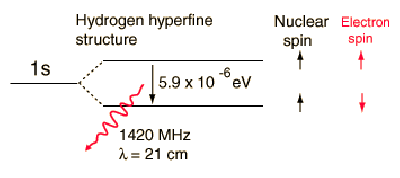Benutzer-Werkzeuge
Dies ist eine alte Version des Dokuments!
Die 21 cm Linie des neutralen Wasserstoffs
Wie vielen Lesern sicher bekannt ist, bestehen die Sterne (und auch unsere Sonne) zu wesentlichen Teilen aus Wasserstoff. Ein gewisser Teil des Wasserstoffs in unserer Milchstraße ist jedoch nicht in Sternen gebunden, sondern bewegt sich frei in Raum umher. Dies ist der sogenannte „interstellare Wasserstoff“, also der Wasserstoff „zwischen den Sternen“. Dabei handelt es sich nicht um molekularen Wasserstoff, wie wir ihn von der Erde kennen, sondern um einzelne Atome. The Dutch astronomer H.C. van de Hulst predicted the existence of an emission line from hydrogen in the interstellar space back in 1945 [1]. This emission originates from a transition between the hyperfine structure levels in the 1s electronic ground state of the hydrogen atom, which differ by the spin orientation of the proton and the electron (fig. 1):
 (Grafik von Link)
(Grafik von Link)
The small energy difference between the two states corresponds to a photon of 21 cm wavelength or a frequency of about 1420 MHz. The excitation of this line is believed to be caused by collisions between the hydrogen atoms in the interstellar space. The collision energy (or parts thereof) is transferred into the atom and then released as electromagnetic radiation as the hydrogen atom transits from the excited state to the energetically lower state.
It is quite amazing when one looks at the numbers which govern this process: The probability of one hydrogen atom colliding with another one in the interstellar space is about once per 60 years. The lifetime of the transition is about 11 million years which means it takes an average of 11 million years after the excitation before the energy is released again in form of electromagnetic radiation. Therefore, the hydrogen emission line is very faint. It is only because we are observing very large volumes that we are able to receive a signal.
